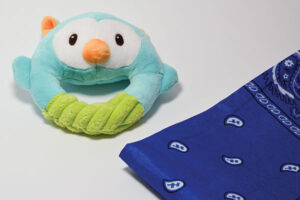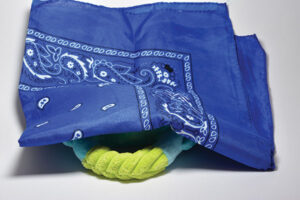Executive function
An infant practices watching a rattle as it is moved by a caregiver.



[Place the infant on his/her tummy on a comfortable blanket or mat in front of you. Sit on the floor very close to the infant so he/she can see your face and hear your voice. Smile and make eye contact with the infant.]
I will put you on your tummy for a short time. You can see me. I will stay close to you.
[Place the rattle in front of the infant.]
Here is a rattle. Would you like to touch it?
[Encourage the infant to touch and explore the rattle for a few moments. If the infant is reluctant to give up the rattle for the next portion of the activity, present the second rattle.]
We are going to play a game of finding the rattle. I am going to move the rattle, and you can find it!
[Place the rattle on top of the small blanket or piece of cloth in front of the infant.]
Do you see the rattle? Where is it?
[Watch the infant’s response closely. Young infants may respond by gazing at the rattle. Acknowledge the infant’s response. Example: “You are looking at the rattle. You found the rattle on top of the blanket!”]
I am going to hide the rattle. Watch and see where I put the rattle!
[This time, with deliberate movements in view of the infant, hide the rattle under the blanket with a portion of the rattle showing. Ensure the rattle is in reach of the infant and that a portion of the rattle is showing.]
Our rattle is hiding! Where is the rattle now? Can you find it?
[Show enthusiasm and excitement if the infant reaches for or gazes at the rattle. Example: “You are reaching for the rattle. The rattle was hiding. You found it under the blanket!”
If the infant remains interested, repeat the above deliberate actions, remembering to keep a portion of the rattle in full view of the infant. Again, show enthusiasm and excitement if the infant reaches for the blanket or rattle.
Acknowledge the infant’s efforts to find the rattle. Examples: “You remembered that I put the rattle under the blanket! You looked for the rattle. Now you are holding the rattle.” “You are looking at the rattle. You found the rattle on the blanket!”
Some infants may be ready for a different position or activity after several minutes. Example: “I can see that you are fussing. Are you ready for a different kind of play? Let’s find something else to do.”]
[Smile and make eye contact with the infant as you describe what happened. Example: “You watched me hide the rattle. You smiled when I took the blanket off the rattle! We found it! We had fun together.”]
Executive function
An infant practices focusing on and remembering the location of a rattle as it is moved by a caregiver.



Invite an infant to sit on your lap to play a game. Have the small blanket, piece of fabric, or scarf close at hand. Place the infant facing out, turned slightly and securely in your arms so he/she is able to make some eye contact with you. With your arms around the infant, introduce the rattle. Encourage the infant to hold and explore the rattle for a few moments. Explain that we are going to play a game of finding the rattle. If the infant prefers to continue holding the rattle, use the second one for the game.
Start by placing the rattle on top of the small blanket or cloth within reach of the infant. Example: “I moved the rattle. Do you see it? You can find the rattle!” Pause for the infant to respond. The infant may reach for or gaze at the rattle. Describe the infant’s response. Example: “You are reaching for the rattle. You found the rattle on the blanket!”
Announce that you are going to hide the rattle. Encourage the infant to watch you move the rattle. With deliberate movements the infant can fully see, place the rattle under the blanket with a portion of the rattle showing. Invite the infant to find the rattle. Show excitement and enthusiasm if the infant reaches for or gazes at the rattle.
Hide the rattle once more with the infant watching, this time completely hidden under the blanket. Encourage the infant to find the hidden rattle. Younger infants will likely be unsure what happened to the rattle, whereas older infants may reach for the blanket and rattle. If the infant is unable to retrieve the rattle, lift the blanket with enthusiasm and show excitement about finding the rattle.
If the infant remains interested, you may wish to hide the rattle under the blanket one more time. Depending on the infant’s response to the last hiding action, you may hide the rattle with a portion showing or hide it completely under the blanket.
Wrap up the activity when the infant begins to lose interest. Example: “I can see that you are done watching the rattle. Let’s find another activity.” Acknowledge the infant’s focus during the activity. Example: “We had fun looking for the rattle, Martina. You watched me hide the rattle. We found the rattle under the blanket! Thank you for playing with me.”
Executive function
An infant practices focusing on and remembering the location of a rattle hidden by a caregiver.



 Invite an infant who can sit independently to play a game with you. Sit facing the infant with a smile and introduce the rattle. Encourage the infant to hold and explore the rattle. Explain that you are going to hide the rattle for the infant to find. Ask the infant if he/she is ready for you to hide the rattle. If the infant prefers to keep holding his/her rattle during the activity, introduce the second rattle for the hiding game.
Invite an infant who can sit independently to play a game with you. Sit facing the infant with a smile and introduce the rattle. Encourage the infant to hold and explore the rattle. Explain that you are going to hide the rattle for the infant to find. Ask the infant if he/she is ready for you to hide the rattle. If the infant prefers to keep holding his/her rattle during the activity, introduce the second rattle for the hiding game.
Encourage the infant to watch your movements as you place the rattle underneath the small blanket or cloth. Leave a portion of the rattle in view. Invite the infant to find the rattle. Example: “You watched me hide the rattle. Do you remember where the rattle is hiding? You can find it!” The infant may reach for the rattle or show awareness of the rattle’s location by gazing at the rattle. Show excitement and enthusiasm as the rattle is revealed.
Hide the rattle again, repeating the above steps. This time, hide the rattle completely under the blanket and out of view. Younger infants may be unsure what happened to the rattle, whereas older infants may reach to remove the blanket. If needed, lift the blanket for the infant, showing enthusiasm and excitement about finding the rattle.
If the infant remains interested, repeat the above steps. Depending on the infant’s reactions to the previous hiding attempts in this activity, you may wish to leave a portion of the rattle showing or hide the rattle completely.
 Transition out of the activity when the infant begins to show signs of disinterest with finding the rattle. Acknowledge the infant’s focus during the activity. Example: “You watched me hide the rattle. You remembered where the rattle was hiding. You found it! I had fun playing this game with you.”
Transition out of the activity when the infant begins to show signs of disinterest with finding the rattle. Acknowledge the infant’s focus during the activity. Example: “You watched me hide the rattle. You remembered where the rattle was hiding. You found it! I had fun playing this game with you.”
These options support infants in learning to focus on an object and remember where the object is hidden. Infants who are beginning to understand that things still exist when they cannot be seen (technically known as object permanence) may easily find the hidden rattle and delight in lifting the blanket to reveal it. All infants should be recognized for efforts to watch the rattle as it is moved and hidden, including partially hidden. The focus (watch) element of the activity is key to the remember element. Younger infants cannot be expected to remember the location of a fully hidden object. Keeping a part of the rattle fully visible to younger infants is consistent with their phase of cognitive development and promotes a positive experience with the activity. Closely watch the infant’s interest in the activity to determine how long to sustain the activity.
Extra support
Enrichment
Materials Needed: small toys, such as rattles
During floor time, invite one or several infants to watch you hide and then find a small toy under a blanket or basket. Leave a portion of the toy exposed for younger infants. Younger infants will benefit from watching their older peers find a completely hidden toy.
Materials Needed: none
Play hide and seek games with children. Older children may hide under a blanket or table. Younger children may prefer to hide behind an object, such as a chair. Infants and young toddlers may enjoy “finding” their peers with help. These games can also be played with familiar toys, such as a ball or large block. Hide the object and invite the children to find it. Alternate between partially and completely hiding the objects.